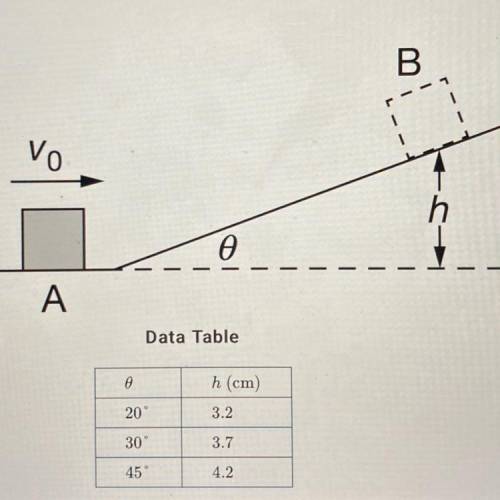
A student must determine the effect of friction on the mechanical energy of a small block as it slides up a ramp. The block is launched with an initial speed vg from
point A along a horizontal surface of negligible friction. It then slides up a ramp, where friction is not negligible, that is inclined at angle with respect to the
horizontal
, as shown in the figure. The student measures the maximum vertical height h attained by the block while on the ramp, labeled as point B in the figure. At
point B, the block comes to rest. The student performs three trials with the ramp at different angles, launching the block at the same initial speed vo for each trial.
The results from the trials are displayed in the table.
Consider the trial with the 45" ramp. Suppose the block is launched up the ramp such that it comes to rest at point B and then travels down the ramp. Which of the
following best describes the block's kinetic energy KA when it again reaches point A at the bottom of the ramp in comparison to the initial kinetic energy K, before
it travels up the ramp?
A KA > Ko, because the object will have a higher speed at the bottom of the ramp after sliding down the ramp than its original launch speed.
B
KA
ramp.
C KA = K , because the law of the conservation of energy states that mechanical energy must be conserved for a closed system.
D
It is impossible to predict how the kinetic energy of the block at point A will compare to the original kinetic energy without knowing the magnitude
of the force of friction that is exerted on the block as it travels up and back down the ramp.


Answers: 3


Another question on Physics

Physics, 22.06.2019 03:30
As part of an industrial process, air as an ideal gas at 10 bar, 400k expands at steady state through a valve to a pressure of 4 bar. the mass flow rate of air is 0.5 kg/s. the air then passes through a heat exchanger where it is cooled to a temperature of 295k with negligible change in pressure. the valve can be modeled as a throttling process, and kinetic and potential energy effects can be neglected. (a) for a control volume enclosing the valve and heat exchanger and enough of the local surroundings that the heat transfer occurs at the ambient temperature of 295 k, determine the rate of entropy production, in kw/k. (b) if the expansion valve were replaced by an adiabatic turbine operating isentropically, what would be the entropy production? compare the results of parts (a) and (b) and discuss.
Answers: 3

Physics, 22.06.2019 13:00
The substances that are necessary for producing of certain hormones and that store and transport vitamins
Answers: 1

Physics, 22.06.2019 14:10
In one or two sentences, describe how you did in the balancing game. in a few more sentences, explain one strategy you learned for balancing more complex equations.
Answers: 2

Physics, 22.06.2019 17:00
The force it would take to accelerate an 900-kg car at the rate of 6m/s2
Answers: 1
You know the right answer?
A student must determine the effect of friction on the mechanical energy of a small block as it slid...
Questions

Biology, 05.10.2020 14:01


Geography, 05.10.2020 14:01


Mathematics, 05.10.2020 14:01






Mathematics, 05.10.2020 14:01



Mathematics, 05.10.2020 14:01

History, 05.10.2020 14:01

Biology, 05.10.2020 14:01

Mathematics, 05.10.2020 14:01


Mathematics, 05.10.2020 14:01

Social Studies, 05.10.2020 14:01



